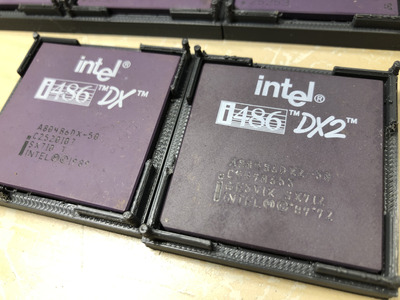aries-mu wrote on 2023-09-29, 08:11:Guys, I was wondering... […]
Show full quote
Guys, I was wondering...
Since VLB mobos can be clocked @40 and even 50 MHz on the bus... I was wondering if it would be possible, for example, to grab an Intel DX4 100 MHz, and, instead of setting up the bus @ 33 MHz, setting it up @ 50 MHz and modify the multiplier to x2 instead of x3. Is something like this possible? What dictates the CPU clock multiplier? The mobo jumpers or the CPU itself? Cause, if the latter, I doubt we can put our hands on it...
Well, and even if we cannot, ASSUMING we could, I wonder what would perform better:
• Intel 486 DX4 100 multiplied at 50 MHz x 2
• AMD 486 DX4 120 with its natural 40 MHz x 3 setting
Everything else the same (same L1 and L2 cache, size and type, same RAM size and type, same 0 wait states on the VLB cards, same SVGA and drive controller... same everything else)
Thanks
CPUs manufactured then were binned/graded based on in-factory testing. Some chips can handle 'incorrect' clocking better than others, depending on multiple factors that were in play when it was manufactured (Billet of silicon it was produced from, what batch of UV sensative etching/resist was used, etc...)
In a more direct answer to your question, there were some "Oddball" 486 chips that had a 1x multiplier. There *WERE* DX-50 chips, for instance. (NOT a DX/2-50, no, I mean a straight up DX-50)
https://dfarq.homeip.net/486dx-50-versus-dx2/
These chips were either "Blazing fast!" or "Cause so much horrible headache that they are useless!!" depending on where and how you put them into service. VLB motherboards for instance, were NOTORIOUS for **NOT** playing nice with these chips, as 50mhz was pushing the extreme edge of what the VLB architecture could accomplish. VLB is designed with a nominal bus speed of 33mhz, and 50mhz is some 50% higher than that. Not all cards could handle being driven that fast, not all implementations of the VLB could tolerate being driven at that speed reliably, and then there were other factors that might come into play (like shitty capacitors with poor noise suppression, crappy wiring in people's houses, people not using grounded outlets, et al.)
The actual answer to your question, is "If the CPU's bus speed stays at or near the nominal 33mhz, there is no real need for a clock multiplier by the chip, except that you will have crummier performance for in-processor applications-- at least as far as IO Bus technologies of the era were concerned." Clock multipliers allowed the chip to do things quickly internally (EG, multiple processor cycles could be done per IO cycle, and software written to take advantage of this fact, could do amazing things) while "Doing the best they could" with on-board discrete components, and the delays and other issues that circuit design and component selection from the era imposed.
I had a 486 that was ISA only; The DX50 I popped in it worked GREAT.
I later got a board that could do VLB, and realized quickly that my DX50 caused me no end of grief.
I sorely missed being able to play MP3s on my 486 (The DX50 could do raw RAM IO fast enough to decode MP3, which was something normally reserved for Pentium species chips) but being able to have better video performance and other gains elsewhere were a fair trade, when "Demoting" to a DX/2-50.
I suppose on a rare PCI equipped 486, the DX50 would be a fine choice. (though that assumes bus-mastering is present on that ancient PCI chipset)
